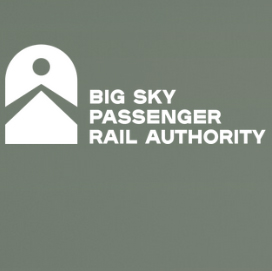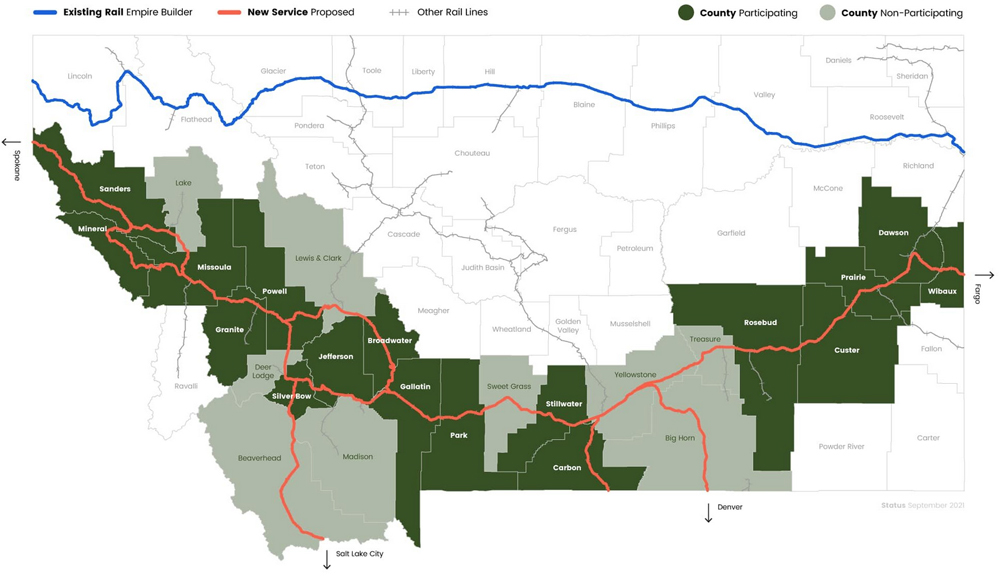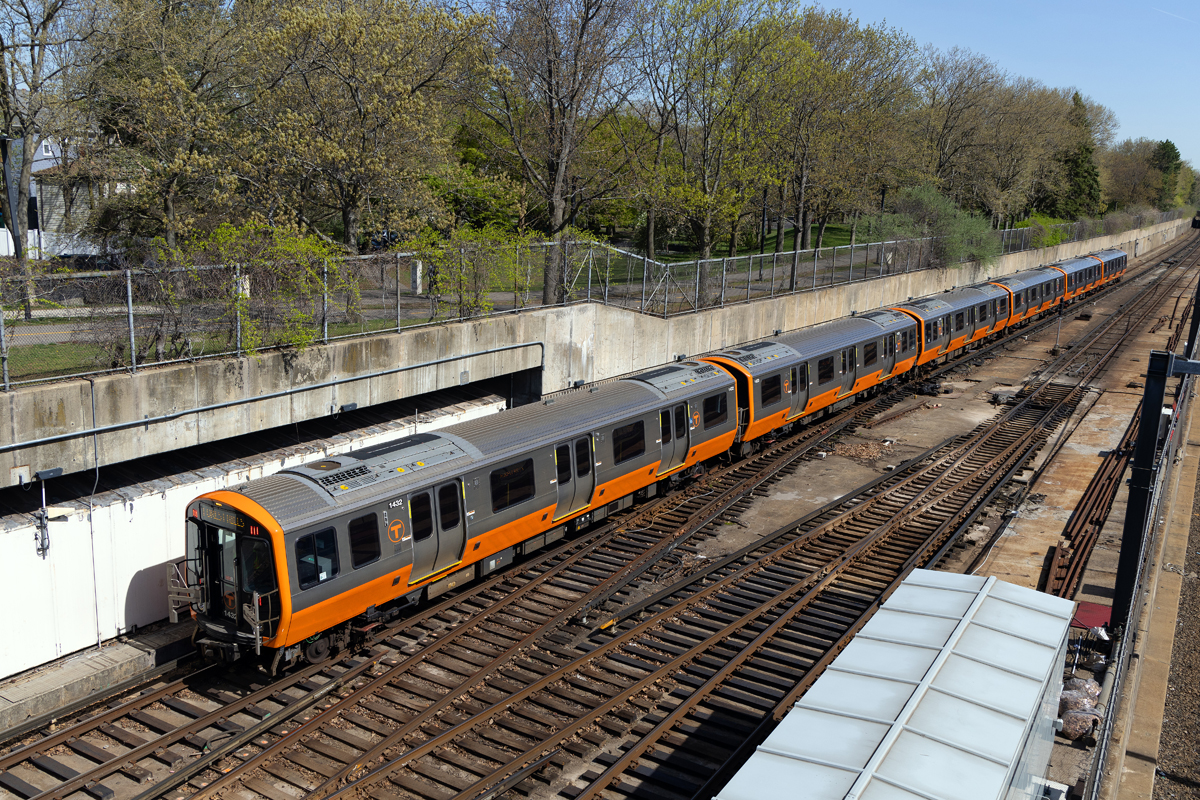 WASHINGTON — In a boost to efforts to reestablish Amtrak service along the former North Coast Hiawatha route, a bipartisan group of eight U.S. senators have asked the Federal Railroad Administration to establish a group to study additional passenger service in the Pacific Northwest.
WASHINGTON — In a boost to efforts to reestablish Amtrak service along the former North Coast Hiawatha route, a bipartisan group of eight U.S. senators have asked the Federal Railroad Administration to establish a group to study additional passenger service in the Pacific Northwest.
The Missoula Current reports the senators — Republicans Mitt Romney (Utah), Kevin Cramer and John Hoeven (North Dakota), and James Risch and Mike Crapo (Idaho), along with Democrats Jon Tester (Montana) and Ron Wyden and Jeff Merkley (Oregon) — requests the FRA establish a Greater Northwest Working Group and work to “expedite” provisions for restoration of service within the Infrastructure Investment and Jobs Act.
The working group would study daily long-distance Amtrak service, explore options to restore additional routes, and find ways for Amtrak to work with local organizations. It would build on the efforts of the Big Sky Passenger Rail Authority, representing a group of Montana counties that have banded together to try to bring back service along the state’s southern tier, last served by the North Coast Hiawatha in 1979.
“This letter solidifies bipartisan support behind expanding passenger rail service in Montana and beyond, including the Greater Northwest region in the nationwide study of abandoned Amtrak long-distance passenger rail routes,” Dave Strohmaier, chaiman of the rail authority, told the Current. “This is a big deal, and local governments in Montana can be proud that they played a major role in making this happen.”















Is any of the track left from when the Pacific Extension was abandoned?
From what I can tell, there’s very little left. Part of the mainline in Butte looks like it’s being used as an industrial spur. I know in Washington and Idaho any remaining portions are used by shortlines. It would not surprise me if most of the roadbed remains, as it does in Washington (turned into a trail).
On the other hand, part of the extension’s downfall is that it took the most direct route to the coast, and thus bypassed several population centers. Rebuilding it would give service to Missoula and Butte, but skip Helena (mutually exclusive to Butte anyway), Bozeman, and Billings, to name a few places. Using the old Northern Pacific line maintains access to these centers.
A lot of good options.. service to Denver which would return psgr service to WY, to the east get ND on board as that route serves the major pop ctrs there. I’m sure the fed/state/local taxpayers throw plenty of $$ to subsidize Essential Air Svc to these communities already which is used by few but is boasted about by their local Chamber of Comm. Sadly I’m sure none of these will ever come to fruition though as state supported psgr rail is such a weak link (other than CA, WA & OR) due to being a political football expanded under one wiped out by another.
Now if we could only get some of these Senators to actually vote to fund Amtrak
There is money in IIJA for Superliner replacement if Amtrak chooses to spend money it has been appropriated in the National Network budget to that cause. You are correct while 66 billion is a lot not all of it goes to Amtrak and 66 billion spent across the United States is not going to give us all the rail some of us would like to see
Besides absolute dollars, this study will not be significantly differ from the one back in 2008 – 2010. That one cost millions, and Amtrak said it had no money. Today, it probably sits on a shelf gathering dust. So, why waste more money on consultants telling us the same thing?
Instead, since Montana has taken the lead perhaps they should start by building, or upgrading stations in Montana where the train would definitely run, or piggy backing on the existing single multi-state car order, possibly use in the short run, and then swap them for future bi-level coaches once Amtrak gets around to placing an order (years from now?)?
I don’t think Montana has taken the lead. Instead, if i got it correctly, it is a coalition looking to organize a county based entity to spearhead which is allowed under state law..
..
No surprises that US Senators got on the band wagon considering that Amtrak getting a boatload of funds of which includes expansion under Amtrak’s plan.
So if I have it correctly, this will be a two-night CHI-West Coast full-service (coach/sleeper/dining car) train. Great. I’d like to see this. But where is the equipment coming from? The Superliners are worn out and as far as I’ve heard there is no $$$ in the IIJA for the purchase of Superliner (or better yet single-level) replacements. And who would build them? And what of possible track capacity issues does another Amtrak train pair on CP’s CHI-St. Paul/Minneapolis line bring on?
Mark your last sentence is actually four different questions being that CP Rail CHI- MSP is four different railroads (1) The Chicago commuter zone up to Roundout (2) the high-speed double track north from Roundout through Kenosha and Racine Counties to Milwaukee (3) the curvy and slow double-track line west from Milwaukee through Wauwatosa, Elm Grove, Brookfield to Forestgrove Avenue in Pewaukee (4) the brain-dead conversion from double iron to single iron west from Pewaukee across Wisconsin.
My understanding is that Wisconsin is already looking into capacity improvements for a second train CHI to MSP.
There is money in IIJA for Superliner replacement if Amtrak chooses to spend money it has been appropriated in the National Network budget to that cause. You are correct while 66 billion is a lot not all of it goes to Amtrak and 66 billion spent across the United States is not going to give us all the rail some of us would like to see
This only makes sense if they look at operating trains between Butte Mt. and Salt Lake City so they could connect The new North coast Hiawatha and the California Zephyr.Then maybe we could also get service to southern California from Salt Lake. The North Coast Hiawatha connects the largest cities in Montana which makes sense,also Billings to Denver makes a great route,then we could get connections to La Junta and the Southwest Chief.
Butte-Salt Lake City and Billings-Denver will never happen. A slow train like the California Zephyr in Utah and Colorado works due to scenery and tourism, but otherwise long-distance trains in the west should be moderately competitive with driving. In these cases, without huge and expensive upgrades to existing infrastructure, running time would be more than twice driving time, and just over half of the Butte-Salt Lake route and nearly all of the Billings-Denver route is currently dark territory. Also, the North Coast Hiawatha wouldn’t go through Butte – instead Helena. The route east of Butte over Homestake Pass has been out of service for over 40 years….
Timothy is correct. After the state of Montana showed no interest in supporting or expanding rail passenger service within the state, the BSPRA was created to unite counties to support the service. But even they acknowledge that there is no way the state is likely to fork out any money for any new service. They expect it to be federally funded.
John: The study you’re referring to is from 2009 and is still available online:
https://nrvrc.org/nrvpassengerrailstudy/resources/research/national/Amtrak_North_Coast_Hiawatha_Study.pdf
Traffic patterns and infrastructure have changed since 2009, so that’s why the study is no longer valid. And while some of the track upgrades have been done, the railroads will be the first to tell you that they were performed for THEIR trains, both present and future. Also, the 2009 dramatically understated the cost in three areas: 1. It assigned no cost to a passenger bypass around Laurel Yard; 2. The infrastructure needs – especially on the Stampede Pass route – were estimated based on traffic pattern during the Great Recession, and 3: It vastly understated station costs. It projected only $17.6 million in station costs ($23 million today) for 17 new stations. In 2020, a report on east-west passenger service across Washington State estimated a cost of $108 million for eight stations alone.
https://leg.wa.gov/JTC/Documents/Studies/East%20West%20Rail/EastWestRail_FinalReportJune2020.pdf
The real interesting thing about the BSPRA wanting a study for the North Coast Hiawatha is that they already commissioned one earlier this year, performed by the Rail Passengers Association:
https://static1.squarespace.com/static/601b3c34aabc2212d364dd39/t/6168ad0dcaac9b26e34c5663/1634250007612/North+Coast+Hiawatha+Restoration.pdf
This study, which they unequivocally stand behind (their words), actually shows that a restored North Coast Hiawatha would have little utility in North Dakota and Montana. While constantly harping that such a train would serve more population centers in those states than the Empire Builder, their own study shows that in pre-Covid FY2019, ridership on the Empire Builder in North Dakota and Montana was 8,276 and 1,720 greater respectively than would be achieved by a North Coast Hiawatha. The study also shows that while North Dakota and Montana have 49% of the route mileage, the two states would produce only 24% of the ridership. Fargo/Moorhead has a metro population about twice that of Bismarck/Mandan, but ridership at the later would be twice that of the former. Sandpoint, Idaho would have much greater ridership than Spokane, and the Tri-Cities would have greater ridership than Seattle. And most amazingly, Bozeman – the stop for Yellowstone National Park, the Big Sky Resort, and Montana’s largest university with by far the largest number of airline boardings in the state because of those factors – would have an annual ridership only 86% that of East Glacier Park along the Empire Builder route, a stop that is only open five months of the year. The study makes no accommodation for tourism or pretty much anything else, it’s all about cherrypicked county population and uniform applied percentages. And the study does not take into account any of these mandatory parameters: Train schedule, station infrastructure, station amenities, additional track infrastructure, crew districts, or infrastructure for mechanical and train inspection requirements.
A more thorough analysis of the RPA “study” is at:
https://www.ebtrain.net/opinions/passenger-train-service-can-offer-many-benefits-to-rural-communities/
To increase revenue and reduce the subsidy, they should look to Japan where operators like JR Kyushu have combined intercity and tourist services into one train, straightforward transport and a fun excursion combined into one.
While passenger service seems unlikely, this map does make a point. Amtrak trains 1/2, 3/4, 5/6 and 7/8 go east to west. Actual people also travel north to south.
Here you have one of the least populated but geographically biggest states (I believe Monana is fourth in size but about 46th in population), with a bunch of twisting, indirect freight routes. Typically if passenger trains are restored to a route which has been freight-only for decades, it won’t be at the same speed. In any event, I have to praise whoever made this map. It shows the true, actual rail routes, not a straight line between cities which would be considerably shorter than what actually exists in the mountains.